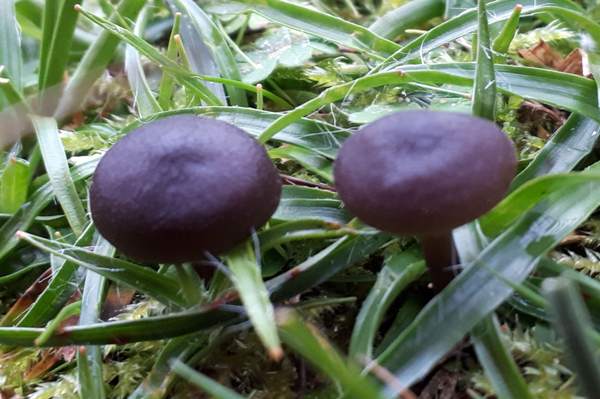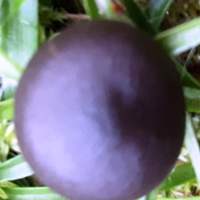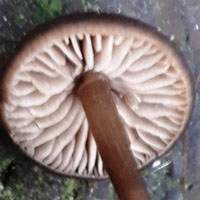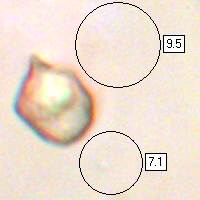Trees Birds Mammals Fish Amphibians Reptiles
Wild Algarve
Bookshop
Entoloma chalybaeum (Pers.) Noordel. - Indigo Pinkgill
Phylum: Basidiomycota - Class: Agaricomycetes - Order: Agaricales - Family: Entolomataceae
Distribution - Taxonomic History - Etymology - Identification - Culinary Notes - Reference Sources

Entoloma chalybaeum grows singly or in small
groups in deciduous woodland. It is most common at high altitude but
does occasionally occur in lowland woods and forests.
Distribution
This poisonous but attractive pinkgill occurs also in grassland and occasionally also on heaths. It is more common in Scotland (particularly, it seems, in the west) and in the north-west of England and Wales than it is elsewhere in the UK.
Taxonomic history
This beautiful mushroom was described scientifically in 1801 by Christiaan Hendrik Persoon, who gave it the binomial name Agaricus chalybeus. (In those early days of fungal taxonomy most gilled fungi were initially placed in a huge Agaricus genus, now redistributed to many other genera.) Its currently accepted scientific name dates from 1982, when Dutch mycologist and Entoloma specialist Machiel Noordeloos (born 1949) transferred the species from Nolonea (where Paul Kummer had sited it in 1871) to the Entoloma genus when the now discarded Nolonea grouping was assimilated into an enlarged Entoloma genus.
Variants of Entoloma chalybaeum are now recognised, and so the nominate form is referred to formally as Entoloma chalybaeum var. chalybaeum (Pers.) Noordel.
Synonyms of Entoloma chalybaeum var. chalybaeum include Agaricus chalybeus Pers., Gymnopus chalybeus (Pers.) Gray, Leptonia chalybaea (Pers.) P. Kumm., Leptonia chalybaea var. chalybaea (Pers.) P. Kumm., and Entoloma chalybaeum (Pers.) Noordel.
The variety Entoloma chalybaeum var. lazulinum (Fr.) Noordel. is similar but has fine radial fibrils on its translucently striate cap. Its synonyms include Agaricus lazulinus Fr., Leptonia lazulina (Fr.) Quél. Rhodophyllus lazulinus (Fr.) Quél., and Entoloma lazulinum (Fr.) Noordel.
Etymology
The generic name Entoloma comes from ancient Greek words entos, meaning inner, and lóma, meaning a fringe or a hem. It is a reference to the inrolled margins of many of the mushrooms in this genus.
The specific epithet chalybaeum came originally from Ancient Greek and into the Latin chalybs, meaning steel (the grey colour of tempered steel as made and traded by the Chaldoi or Chalybes, ironsmiths of the Black Sea coast).
Note on epithet spelling variants
Sometimes chalybaeum is written chalybeum, and chalybaea is written chalybea. We have followed Dutch Entoloma specialist Machiel Noordeloos, as well as Funga Nordica, in using the aeu and aea forms.
Identification guide
 |
Cap
The cap
of Entoloma chalybaeum is convex and umbilicate; dark steel blue; finely tomentose or finely squamulose; 2 to 5cm in diameter. |

|
Gills
White at first, sometimes with a faint bluish tinge; becoming dirty salmon pink later; rather thick and moderately spaced. |
 |
Spores
Heterodiametrical with 5 to 9 sides; 8.5-12.5 x 6-8.5µm; .
Spore print
Pale pink. |
Stem |
Striped with blue fibres over a white base,
the cylindrical stem turns brown as the fruiting body ages. |
Odour/taste |
Not distinctive. |
Habitat & Ecological role |
Usually in small groups or singly in moist
upland forests and occasionally in lowland areas. Sometimes occurring in short-sward unimproved grasslands. |
Season |
Summer and autumn. |
Occurrence |
Rare in lowland areas; occasional in the
uplands. |
Similar species |
There are several 'blue' mushrooms in the Entoloma genus,
including Entoloma serrulatum,
which is generally smaller than Entoloma chalybaeum and has black flecked serrulate (finely saw-toothed) gill edges. |
Culinary Notes
Entoloma chalybaeum is reported to be inedible. Note also that some Entoloma species with which Entoloma chalybaeum could be confused are known to be poisonous.
Reference Sources
Fascinated by Fungi, 2nd Edition, Pat O'Reilly 2016, reprinted by Coch-y-bonddu Books in 2022.
Knudsen H., Vesterholt J. (eds) Funga Nordica: agaricoid, boletoid and cyphelloid genera - Nordsvamp, 2008
Dictionary of the Fungi; Paul M. Kirk, Paul F. Cannon, David W. Minter and J. A. Stalpers; CABI, 2008
Taxonomic history and synonym information on these pages is drawn from many sources but in particular from the British Mycological Society's GB Checklist of Fungi.
Top of page...
Fascinated by Fungi. Back by popular demand, Pat O'Reilly's best-selling 450-page hardback book is available now. The latest second edition was republished with a sparkling new cover design in September 2022 by Coch-y-Bonddu Books. Full details and copies are available from the publisher's online bookshop...